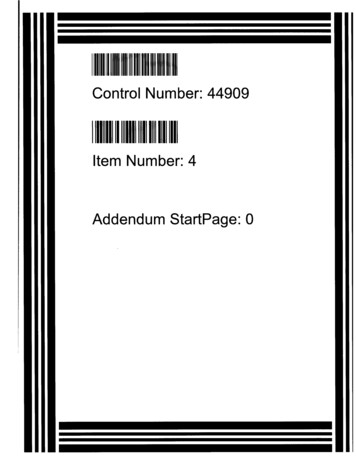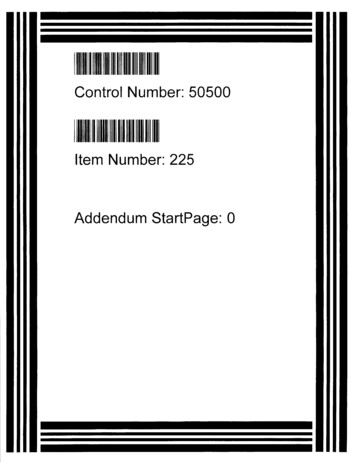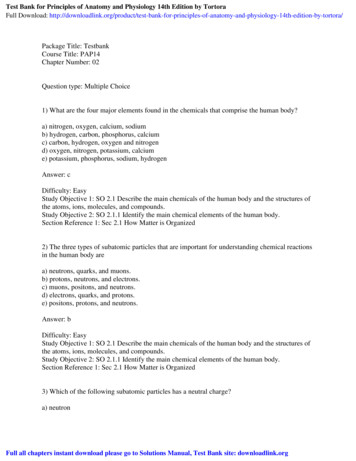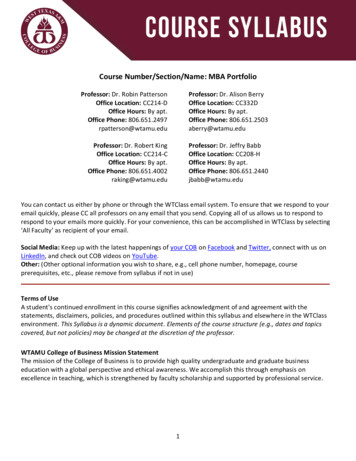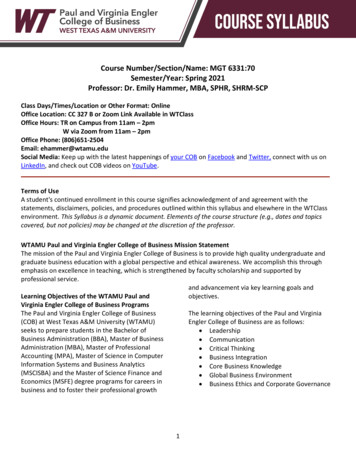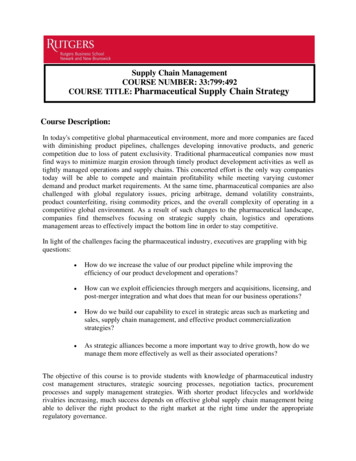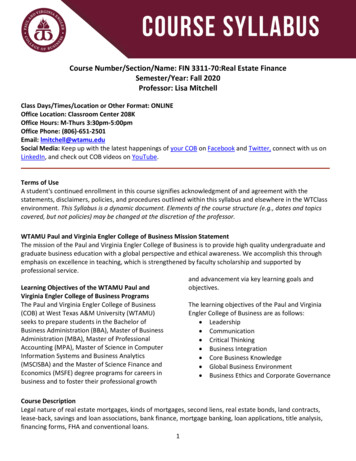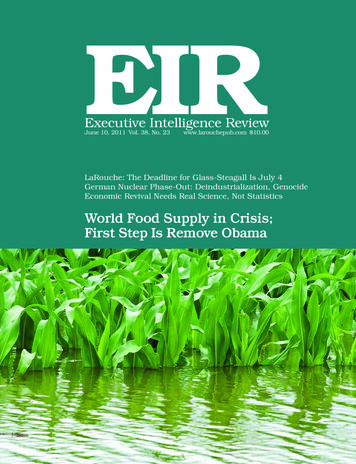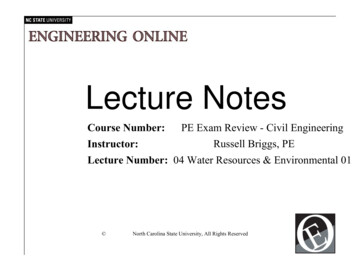
Transcription
Lecture NotesCourse Number:PE Exam Review - Civil EngineeringRussell Briggs, PEInstructor:Lecture Number: 04 Water Resources & Environmental 01 North Carolina State University, All Rights Reserved
P.E. ReviewWater Resources&Environmental
Introduction Expectations of this review How many problems do you need to know to pass? The one page in Lindeburg that you need to know Topics we will cover
Russell Briggs, P.E.BSCE, MSCENC State23P.E. Registration No. 11889 (1984)Current Registration #s are 39000 2/3 of all PE registrations ever conferred after 1984.Principal in B&F Consulting.I use the material from this review daily.
Introduction Expectations of this review How many problems do you need to know to pass? The one page in Lindeburg that you need to know Topics we will cover
What this course is:A review of Water Resources & EnvironmentalA means to prepare by illustrating typical problemsyou may encounter.What this course isn’t:A high school algebra classA means to show every problem you may see onthe exam.An exhaustive treatment of the topics selected thatwe will review.
Introduction & Contact information Expectations of this review How many problems do you need to know topass? The one page in Lindeburg that you need to know Topics we will cover
Passing Rate is /- 70%80 Problems, means you must score correctly on70% x 80 56 ProblemsMultiple choice, so if you “know” 48 problems, andguess on the remaining 32, you should scorecorrectly48 (25% X 32) 56 ProblemsThen, actually, 48/80, or 60% is the number ofproblems you must “know”.Strategy: get all the morning problems, then, afteryou do 8 problems in the afternoon, you canleave early say around 2 p.m.
How many problems would a 1st grader score correctly?20 out of 80Correct from guessingFirst-grader score“4 years of experience &16 years of education”8202856The State of North Carolina will confer upon you thetitle of Professional Engineer if you “know” 28 moreproblems than a first-grader answers correctly on an80 problem test.
Introduction Expectations of this review How many problems do you need to know topass? The one page in Lindeburg you must know Topics we will cover
Page 28-2
Municipal Solid Waste
The Engineer sees:
The Test-Maker sees:
A Municipality has an aggressive infiltrationand inflow program that minimizes stormwaterand groundwater flow into the sewer system.Therefore, what is the most likely size of awastewater treatment plant for a municipalitythat has a 2 MGD water treatment plan?a) 1.0 MGDb) 1.4 MGDc)d)2.0 MGD2.8 MGD
A Municipality has an aggressive infiltrationand inflow program that minimizes stormwaterand groundwater flow into the sewer system.Therefore, what is the most likely size of awastewater treatment plant for a municipalitythat has a 2 MGD water treatment plan?a) 1.0 MGDb) 1.4 MGDc)d)2.0 MGD2.8 MGD2 MGD Water Treatment X 75% return 1.5 MGD Wastewater Treatment
What is the best estimate, in MGD, of sewerflow for new development for 2300 people?a) 0.2 MGDb) 0.5 MGDc)d)0.1 MGD0.8 MGD
What is the best estimate, in MGD, of sewerflow for new development for 2300 people?a) 0.2 MGDb) 0.5 MGDc)d)0.1 MGD0.8 MGD2300 people X 100 gpd/person 230,000 gpd 0.23 MGD
Combined sewer systems occur most often ina)b)c)d)Planned developmentsOlder citiesCaliforniaRural counties
Combined sewer systems occur most often ina)b)c)d)Planned developmentsOlder citiesCaliforniaRural counties
Introduction Expectations of this review How many problems do you need to know topass? The one page in Lindeburg you must know Topics we will coverncees.org
Civil Breath (AM) ExamEIGHT Questions fromWater Resources and Environmentalincluding:A.B.C.D.E.Hydraulics – Closed ConduitHydraulics – Open ChannelHydrologyWastewater TreatmentWater Treatment
A. Hydraulics – Closed Conduit- Energy and/or Continuity Equation- Pressure Conduit (e.g. force mains)- Closed pipe flow equationsHazen-Williams, Darcy-Weisbach- Friction/Minor Losses- Pipe network analysise.g. pipeline design, loop networks- Pump application and analysis
Civil Breath (AM) ExamEIGHT Questions from Water Resourcesand Environmental including:A.B.C.D.E.Hydraulics – Closed ConduitHydraulics – Open ChannelHydrologyWastewater TreatmentWater Treatment
B. Hydraulics – Open Channel- Open-channel flow (e.g. Manning’s eq.)- Culvert design- Spillway capacity- Energy dissipation (hydraulic jump)- Stormwater collection (inlets, gutterflow, street flow, storm sewer pipes)- Flood plains/floodways- Flow measurement – open channel
Civil Breath (AM) ExamEIGHT Questions from Water Resourcesand Environmental including:A.B.C.D.E.Hydraulics – Closed ConduitHydraulics – Open ChannelHydrologyWastewater TreatmentWater Treatment
C. Hydrology- Storm characterization- Storm frequency- Hydrographs application- Rainfall intensity, duration and frequency- Time of concentration- Runoff analysis (Rational & NRCS)- Erosion- Detention/retention ponds
Civil Breath (AM) ExamEIGHT Questions from Water Resourcesand Environmental including:A.B.C.D.E.Hydraulics – Closed ConduitHydraulics – Open ChannelHydrologyWastewater TreatmentWater Treatment
D. Wastewater Treatment- Collection systemslift stations, sewer networksinfiltration and inflow- Rainfall intensity, duration and frequency- Time of concentration- Runoff analysis (Rational & NRCS)- Erosion- Detention/retention ponds
Civil Breath (AM) ExamEIGHT Questions from Water Resourcesand Environmental including:A.B.C.D.E.Hydraulics – Closed ConduitHydraulics – Open ChannelHydrologyWastewater TreatmentWater Treatment
E. Water Treatment- Hydraulic loading- Distribution systeminfiltration and inflow- Rainfall intensity, duration and frequency- Time of concentration- Runoff analysis (Rational & NRCS)- Erosion- Detention/retention ponds
Transportation Depth (PM) ExamTen Questions from Other TopicsA. Hydraulics- Flow measurement – closed conduits- Open channel, sub & supercritial flowB. Hydrology- Hydrograph development & syntheticC. Engineering properties of soils & materialsD. Soil mechanics analysisE. Engineering EconomicsF. Construction operations and methods- NPDES permittingG. Temporary structures
A.B.C.D.E.Geotechnical Depth (PM) ExamFive Questions from Other TopicsGroundwater and well fields- Well logging and subsurface properties- Aquifers- Groundwater flow (Darcy’s law)- Well analysis (steady flow only)- Groundwater control (drainage, deh20)LoadingsConstruction operations & methodsTemporary structuresWorker health, safety and environment
Structures Depth (PM) ExamNO Questions from Water Resources &Environmental topics
Water Resources &Environmental (PM) Exam39 questionsA. Hydraulics – Closed ConduitB. Hydraulics – Open ChannelC. HydrologyD. Groundwater and well fieldsE. Wastewater TreatmentF. Water QualityG. Water Treatment
A. Hydraulics – Closed Conduit ( /-6 questions)- Energy and/or Continuity Equation- Pressure Conduit (e.g. force mains)- Closed pipe flow equationsHazen-Williams, Darcy-Weisbach- Friction/Minor Losses- Pipe network analysise.g. pipeline design, loop networks- Pump application and analysis- Cavitation- Transient analysis (e.g. water hammer)- Flow measurement – closed conduits- Momentum equation (thrust block)
B. Hydraulics – Open Channel ( /- 6 questions)- Open-channel flow (e.g. Manning’s eq.)- Culvert design- Spillway capacity- Energy dissipation (hydraulic jump)- Stormwater collection (inlets, gutterflow, street flow, storm sewer pipes)- Flood plains/floodways- Flow measurement – open channel- Gradually varied flow
C. Hydrology ( /-6 questions)- Storm characterization- Storm frequency- Hydrographs application- Rainfall intensity, duration and frequency- Time of concentration- Runoff analysis (Rational & NRCS)- Erosion- Detention/retention ponds- Hydrograph development, synthetic- Depletions (transpiration, evap, infiltration)- Sedimentation
D. Groundwater and Well Fields ( /- 3 quest.)- Aquifers (e.g. characterization)- Groundwater flow (Darcy’s law)- Seepage analysis- Groundwater control, drainage, dewatering- Water quality analysis- Groundwater contamination- Erosion- Detention/retention ponds- Hydrograph development, synthetic- Depletions (transpiration, evap, infiltration)- Sedimentation
E. Wastewater Treatment ( /- 6 questions)- Collection systemslift stations, sewer networksinfiltration and inflow- Wastewater flow rates- Unit operations and processes- Primary & Secondary treatment- Secondary clarification- Biological & Physical treatment- Solids handling ( thickening, drying)- Disinfection, nitrification, denitrification- Operations (e.g. odor & corrosion cntl)- Advanced treatment, etc. etc. etc.
F. Water Quality ( /- 6 questions)- Stream degradation (e.g. thermal, baseflow, TDS, TSS, BOD, COD)- Oxygen dynamics (oxygen sag curve)- Risk assessment and management- Toxicity- Biological contaminants (algae, mussels)- Chemical contaminants (organics, metals)- Bioaccumulation- Eutrophication- Indicator organisms and testing- Sampling and monitoring (eg QA/QC,laboratory procedures)
G. Water Treatment ( /- 6 questions)- Hydraulic loading- Distribution system- Demands- Storage (raw and treated water)- Sedimentation- Taste and odor control- Rapid mixing- Coagulation and flocculation- Filtration- Disinfection- Advanced treatment (membranes,activated carbon, desalination)
2/3 of all PE registrations ever conferred after 1984. Principal in B&F Consulting. . Geotechnical Depth (PM) Exam Five Questions from Other Topics A. Groundwater and well fields - Well logging and subsurface properties - Aquifers - Groundwater flow (Darcy’s law) - Well analysis (steady flow only) - Groundwater control (drainage, deh20) B. Loadings C. Construction operations & methods D .

